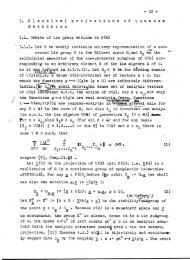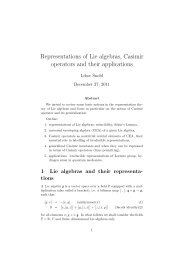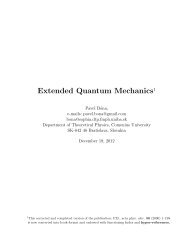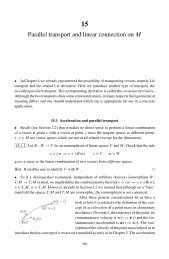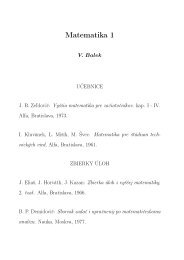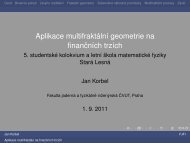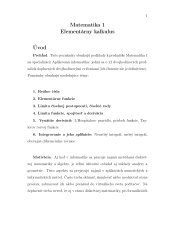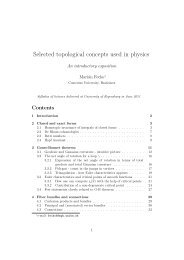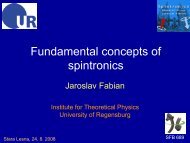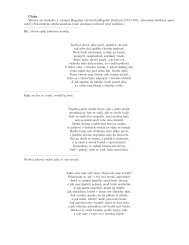Quantum Field Theory I
Quantum Field Theory I
Quantum Field Theory I
You also want an ePaper? Increase the reach of your titles
YUMPU automatically turns print PDFs into web optimized ePapers that Google loves.
1.2. MANY-BODY QUANTUM MECHANICS 31<br />
1.2.4 The bird’s-eye view of the solid state physics<br />
Even if we are not going to entertain ourselves with calculations within the<br />
creation and annihilation operatorsformalism of the non-relativistic many-body<br />
QM, we may still want to spend some time on formulation of a specific example.<br />
The reason is that the example may turn out to be quite instructive. This,<br />
however, is not guaranteed. Moreover,the content ofthis section is not requisite<br />
for the rest of the text. The reader is therefore encouraged to skip the section<br />
in the first (and perhaps also in any subsequent) reading.<br />
The basic approximations of the solid state physics<br />
∆ i<br />
2M −∑ ∆ j<br />
j<br />
∑<br />
8π i≠j<br />
A solid state physics deals with a macroscopic number of nuclei and electrons,<br />
interacting electromagnetically. The dominant interaction is the Coulomb one,<br />
responsible for the vast majority of solid state phenomena covering almost everything<br />
except of magnetic properties. For one type of nucleus with the proton<br />
number Z (generalization is straightforward) the Hamiltonian in the wavefunction<br />
formalism 37 is H = − ∑ i<br />
U( R) ⃗ = 1 ∑<br />
Z 2 e 2<br />
8π i≠j | R ⃗ i−R ⃗ , V(⃗r) = 1<br />
j|<br />
and (obviously) R ⃗ = ( R ⃗ 1 ,...), ⃗r = (⃗r 1 ,...). If desired, more than Coulomb can<br />
be accounted for by changing U, V and W appropriately.<br />
Although looking quite innocent, this Hamiltonian is by far too difficult to<br />
calculate physical properties of solids directly from it. Actually, no one has ever<br />
succeeded in proving even the basic experimental fact, namely that nuclei in<br />
solids build a lattice. Therefore, any attempt to grasp the solid state physics<br />
theoretically, starts from the series of clever approximations.<br />
The first one is the Born-Oppenheimer adiabatic approximation which enables<br />
us to treat electrons and nuclei separately. The second one is the Hartree-<br />
Fockapproximation,whichenablesustoreducetheunmanageablemany-electron<br />
problem to a manageable single-electron problem. Finally, the third of the<br />
celebrated approximations is the harmonic approximation, which enables the<br />
explicit (approximate) solution of the nucleus problem.<br />
These approximations are used in many areas of quantum physics, let us<br />
mention the QM of molecules as a prominent example. There is, however, an<br />
important difference between the use of the approximations for molecules and<br />
for solids. The difference is in the number of particles involved (few nuclei<br />
and something like ten times more electrons in molecules, Avogadro number<br />
in solids). So while in the QM of molecules, one indeed solves the equations<br />
resulting from the individual approximations, in case of solids one (usually)<br />
does not. Here the approximations are used mainly to setup the conceptual<br />
framework for both theoretical analysis and experimental data interpretation.<br />
In neither of the three approximations the Fock space formalism is of any<br />
great help (although for the harmonic approximation, the outcome is often formulated<br />
in this formalism). But when movingbeyondthe three approximations,<br />
this formalism is by far the most natural and convenient one.<br />
2m +U(⃗ R)+V(⃗r)+W( R,⃗r), ⃗ where<br />
e 2<br />
|⃗r , W(⃗ i−⃗r j|<br />
R,⃗r) = − 1 ∑<br />
Ze 2<br />
8π i,j | R ⃗ i−⃗r j|<br />
37 If required, it is quite straightforward (even if not that much rewarding) to rewrite<br />
the Hamiltonian in terms of the creation and annihilation operators (denoted as uppercase<br />
and lowercase for nuclei and electrons respectively) H = ∫ ( )<br />
d 3 p p<br />
2<br />
2M A+ ⃗p A ⃗p + p2<br />
2m a+ ⃗p a ⃗p +<br />
e 2 ∫ )<br />
8π d 3 x d 3 1<br />
y<br />
(Z 2 A + |⃗x−⃗y| ⃗x A+ ⃗y A ⃗yA ⃗x −ZA + ⃗x a+ ⃗y a ⃗yA ⃗x +a + ⃗x a+ ⃗y a ⃗ya ⃗x .



